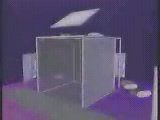Projection-Based Virtual Environments and Disability
June 1st, 1993
Categories: Devices, Human Factors

Authors
Browning, D., Cruz-Neira, C., Sandin, D., DeFanti, T.About
The Electronic Visualization Laboratory at the University of Illinois at Chicago has developed a new virtual reality interface called the CAVE™ (CAVE Automatic Virtual Environment).
It surrounds the viewer with projected images of a virtual environment. Three rear-projection screens make up three walls of a ten-foot cube that all but disappear when illuminated with computer graphics. A fourth data projector illuminates the floor for complete immersion. The viewer can move around the virtual environment and see his own body as he interacts with real and virtual objects.
This paper describes the use of a projection-based virtual reality (VR) interface (the CAVE™) for persons with disability. It compares the projection paradigm with the more common VR technologies of head or boom-mounted displays and their associated position sensing techniques. In particular, advantages and disadvantages of the CAVE™ are discussed in terms of disability issues.
These include shared or guided experiences, physical access to the technology, intrusiveness on the user and inclusion of real world objects in the environment.
Finally, appropriate disability related applications for projection based virtual environments are considered in light of the inherent properties.
Resources
URL
Citation
Browning, D., Cruz-Neira, C., Sandin, D., DeFanti, T., Projection-Based Virtual Environments and Disability, Proceedings of the First Annual International Conference, Virtual Reality and People with Disabilities, June 1st, 1993. http://www.evl.uic.edu/drew/proj_vr.htm